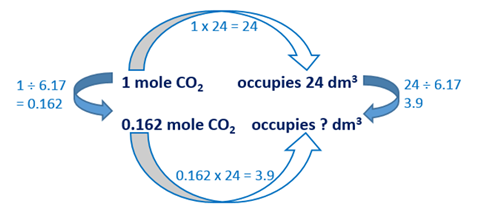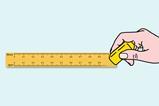Principles to help students with specific learning differences to sequence long sums will also support all students

In your class
Download this set of formatted and scaffolded multi-step calculations (MS PowerPoint or pdf). These include a titration problem with additional guidance.

Students often have difficulty sequencing longer maths tasks. They struggle to retain information in their working memory to maintain the thread of longer, multi-step calculations. The recent increases in mathematical demand in some science curriculums has increased this challenge for many students.
Tricky maths problems become more of a problem for students under stress, as the amount of information a student can hold in working memory decreases. These issues are multiplied if the student has maths anxiety or is working under test conditions or in a noisy classroom.
Exam questions without scaffolding can present particular problems for students with dyslexia and other specific learning differences (SpLD). We tend to think of dyslexia as a problem with spelling and reading. While sometimes true, dyslexia also has an impact on maths. Students with SpLD may have strong non-verbal reasoning, but find it difficult to articulate their thinking.
Interventions shown to help students with SpLDs, such as dyslexia, dyspraxia and dyscalculia, often help other students as well. So, whether or not you teach students with SpLDs, these strategies for helping students sequence steps and articulate their thinking are worth following.
Build up the basics
Students need to carry out each separate step fairly automatically for success in multi-step calculations. Ensure students have the following maths skills before applying them to a multi-step problem.
1. Handling units
Students should include units throughout a calculation. This is important for two reasons. Firstly, it is more obvious if they need to convert units. For example, if a concentration is given in g dm-3 but a volume is given in cm3 the volume should be converted to dm3 before substituting into the formula. Secondly, it’s a useful way of checking for errors. If students end up with the units for concentration as dm3 g-1, they know they’ve made a mistake.
Additionally, more familiarity with units means students know which units are used for each type of measurement (eg dm3 for volume, g for mass), and recognise that something measured in dm3 relates to a volume.
2. Making sense of formulas
Understanding that concentration is how much solute is present in a certain volume of liquid helps to make sense of the formula, because the formula represents, in words, the amount per volume. Something concentrated has a large amount in a relatively small volume.

Ensure students also grasp that, for example, the molar mass is the mass per mole of a substance. So, a very large atom or molecule will have a large molar mass because each atom or molecule is bigger.
3. Speaking the language
Encouraging students to talk through what they are doing in a calculation helps them embed the appropriate language. For example, it helps them make the link between ‘per’ and ‘divide’.
4. Using ratio and proportion
Students often need help setting out answers to questions involving ratio and proportion. For example, if we know that 1 mole of CO2 gas occupies 24 dm3, what volume would 0.162 mole of CO2 gas occupy?
Encourage students to think through this calculation. We have a ratio of 1 mole CO2 to 24 dm3 volume. To get from 1 to 24 we multiply by 24. So to work out the volume for 0.162 mole CO2, we multiply 0.162 by 24 to get 3.9 dm3.

Scaffold it together
Once students are comfortable with calculation basics, model the process for solving a multi-step calculation.
Example problem
Make 20.0 g of copper chloride from copper carbonate and dilute acid. The equation for the reaction is:
CuCO3 + 2HCl → CuCl2 + H2O + CO2
Relative atomic masses, Ar: H = 1; C = 12; O = 16; Cl = 35.5; Cu = 63.5
Calculate the mass of copper carbonate you should react with dilute hydrochloric acid to make 20.0 g of copper chloride.
5. Provide the narrative
First, describe what the question tells you and what it asks you to do.
For the example problem above, you might say, ‘The balanced chemical equation tells me one mole of copper carbonate gives me one mole of copper chloride. Moles are our currency in chemistry. I know the mass of copper chloride. So, I first have to work out the number of moles that corresponds to. Once I know this, I can say how many moles of copper carbonate would be required, and then I can convert that into grams to get the answer.’
6. Signpost steps
Write signposts that describe what is done at each step.
7. Colour code
Colour helps students make connections between the different parts of the chemical equation and the calculations. People with SpLDs who are good at making connections can still find links become obscured when buried within a lot of text.
8. Put equations before numbers
Present the equation needed before substituting numbers to do the calculation.
9. Format carefully
Avoid visual stress by setting out working in plenty of white space. Set fractions out visually as a over b, not inline as a / b. Most word processors have an ‘Insert equation’ function.
Vary on a theme
While this sort of scaffolding is useful for introducing multi-step calculations, it becomes more powerful when you vary questions. For example, we could be given the mass of the starting material and need to calculate the mass of the product.
Ask students what other ways the question could be asked – ie how much HCl is required or how much CO2 is produced? Then get students to write their own scaffolded answer. Giving students information and asking them what they can find out from it is known as ‘goal-free problems’ in maths education.

In your class
Download this set of formatted and scaffolded multi-step calculations (MS PowerPoint or pdf). These include a titration problem with additional guidance.
In your class
Visit the Education in Chemistry website to download this set of formatted and scaffolded multi-step calculations (rsc.li/2Cmazsc). These include a titration problem with additional guidance.
Jenny Koenig is an education consultant based in Cambridge. She has previously taught secondary and tertiary science.
Downloads
Tips for scaffolding multi-step calculations
PowerPoint, Size 0.28 mbTips for scaffolding multi-step calculations
PDF, Size 0.58 mb














No comments yet